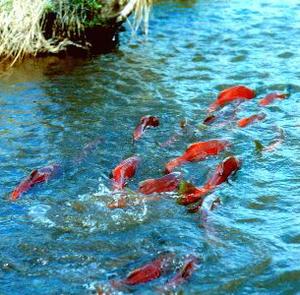SAN FRANCISCO, California, February 5, 2009 (ENS) -
Conservation and fishermen's groups filed a lawsuit Wednesday in
California Superior Court seeking to force state and regional water boards
to implement existing clean water laws in the wild rivers and streams of the
state's North Coast region.
The groups argue that only cleaner waters will enable the recovery of
endangered salmon species.
For decades, water quality in North Coast river and streams has been
degraded by sediment, nutrients, high temperatures, low dissolved oxygen
levels, and turbidity. These pollutants are the result of dam construction,
water diversions, urban development, agriculture, logging, mining, and
grazing.
The declining river and stream conditions have impacted the survival of
regional salmon species, including chinook salmon, coho salmon, and Northern
California steelhead, which are now listed under the federal Endangered
Species Act.
Last year, the collapse of salmon stocks on the west coast caused the first
ever complete shutdown of the commercial salmon fishing season.
"Regional and state officials have failed to develop realistic, workable
action plans that protect water quality and provide habitat for endangered
salmon that need cool, clean water to survive," said George Torgun of the
public interest law firm Earthjustice, who is representing the coalition in
court.
"Without such plans, water quality in North Coast rivers and streams will
not meet the standards that the state is obligated to achieve," he said.
"We need abundant populations of salmon for long-term economic stability and
for our future generations of fishermen," said Glen Spain, northwest
regional director of the Pacific Coast Federation of Fishermen's
Associations, a commercial fishing industry trade association that is a
co-plaintiff in the suit.

Endangered salmon spawning in a California stream
(Photo courtesy California Nature Tours)
"Providing the conditions necessary for salmon to survive could bring back
tens of thousands of fishing jobs and a billion dollar industry to our
region," said Spain.
The action plans at issue are part of the Clean Water Act's Total Maximum
Daily Load, TMDL, program. A TMDL is the maximum amount of a pollutant that
a waterbody can receive in 24 hours and still meet water quality standards.
The program first requires the agencies to identify and maintain a list of
impaired rivers and streams and submit that list to the U.S. EPA for
approval.
The agencies must then assess the sources of pollution causing the
violations, set TMDL limits for these sources, and develop action plans to
achieve the standards.
In 1995, many of the same organizations involved in the current legal
action, sued the EPA for failure to address water quality problems under the
TMDL program. That case resulted in a consent decree requiring the federal
agency to set pollution limits for 17 listed water bodies within the region
by 2007.
EPA has completed most of the work required by the consent decree and TMDLs
have been established for Garcia River, Scott River, and Shasta River.
But except for those three rivers, the North Coast Regional Water Quality
Control Board and the State Water Resources Control Board have failed to
prepare action plans as required by the state Porter-Cologne Water Quality
Control Act and the federal Clean Water Act.
In their complaint, the groups recognize that the North Coast Regional Water
Quality Control Board, has suffered from deep cuts in staffing and funding
for clean water programs.
"While the Regional Board appears to be making some progress, they have lost
60 staff members since 2001, leaving the agency unable to protect our wild
rivers," said Daniel Myers, representing Sierra Club's Redwood Chapter, one
of the plaintiff groups.
"The ecological collapse in our rivers is bad not just for fish, but also
for the thousands of people and local communities that depend on the health
of these rivers," said Georgianna Wood of the plaintiff Northcoast
Environmental Center. "These pollution problems may be complex, but the
state and regional boards have the tools they need to act, and we urge them
to do so."
Copyright Environment News Service (ENS) 2009. All rights reserved.
To subscribe or visit go to: http://www.ens-newswire.com